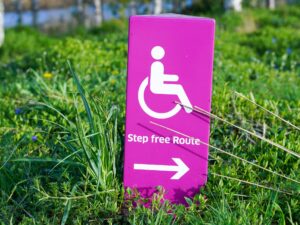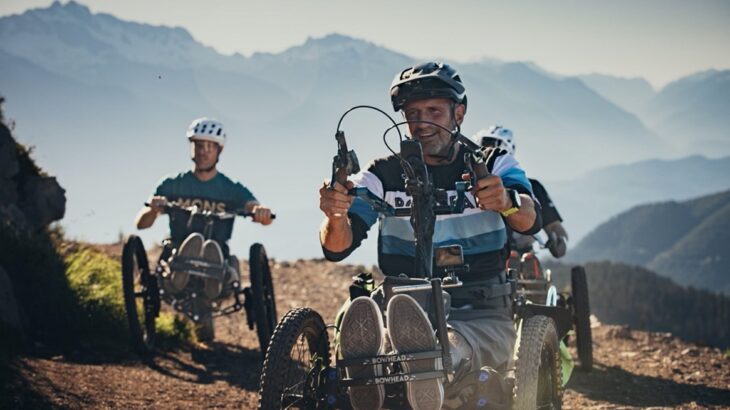By Naeema Bhyat, Technology & Engineering editor
Christian Bagg was looking to get back into mountain biking years after a snowboarding injury to his spinal cord prevented him from using a conventional bike. He developed a rugged, stable, three-wheeled, hand-powered bike. In the process, he founded Bowhead, a Calgary-based company that makes adaptive mountain bikes.
Bowhead is one of many companies that are developing new assistive and adaptive technologies. These include startups and large companies like Toronto-based payment processor Moneris, all the way to multinationals like Apple, Google and Microsoft.
Assistive technologies are technologies that reduce barriers for people with disabilities to do various activities. They may be purposely designed to be assistive, like closed captioning, or they may be mass-marketed devices, like Alexa or Google Assistant. Assistive technologies also benefit people outside the disability community, and they often make life easier for many people. Adaptive technologies are assistive technologies designed specifically for people with disabilities, such as wheelchairs or screenreaders.
Twenty percent of Canadians 15 years or older live with one or more disabilities and thirty-eight percent of that group are seniors 65 or older. As this older demographic grows, many more of us will benefit from assistive technologies in the future. These figures don’t include people affected by temporary or situational disabilities, which could be any of us at different times. Considered this way, everybody can benefit from assistive technologies.
According to Dr. Mahadeo Sukhai, this reality suggests it’s time to shift our perspective on technology development and assistive technologies to include a much broader view of who might use a technology and how they might do it. Sukhai is Vice President, Research and International Affairs and Chief Accessibility Officer at the Canadian National Institute of the Blind (CNIB). “When it comes down to user-centric design, how do we conceptualize the user?” he says. “The problem is that most human beings imagine people who look just like us and who function just like us.”

Ramps are an assistive technology that benefits people both inside and outside the disability community. Photo: Yomex Owo, Unsplash.
In Sukhai’s view, we would all be better served by designing for everyone instead of specific groups of people or simply the majority. “If you put an engineering challenge in front of somebody that says, ‘I need this to work for people who are blind or partially sighted,’ then the default thinking is, ‘I need to design only for people who are blind or partially sighted and it can’t work for anybody else.’” He says, “Why not build the thing that’s good for everybody?”
Everybody, he says, should include technology users across the range of functional abilities: those who have vision and/or hearing loss, people with or without good hand-eye coordination or dexterity, technology users who are paraplegic, on the autism spectrum, neurodivergent or who don’t have focus and concentration and, “don’t have time to figure out a tutorial.”
Sukhai says, “Conceptually, something that theoretically works for the disability community should work for everybody.” He points to examples like ramps that benefit people using wheelchairs and walkers and also people pushing strollers, rolling a dolly or carrying heavy loads.
As Sukhai suggests, concept and design are key to making technologies effective. The process starts with understanding the needs, interests and challenges of possible tech users and conceptualizing the problems a technology will solve. “You start with the universal design principles,” Sukhai recommends, “and you go to the principles of product development. You go to the principles of conceptualizing, ‘who is your target audience,’ to be truly inclusive of everybody on the planet…” This approach avoids one-size-fits-all solutions that force users to fit the technology.
Assistive technologies that are well-conceptualized, well-designed and well-built can be life-changing. Like Bagg’s bike, they allow users to rejoin activities they previously enjoyed or participate more easily and independently in education, work and daily life. Sukhai suggests a longer-term perspective on technology development could ultimately be more cost-effective and profitable than expensive niche technologies developed to do a single task for a small group or technologies that aren’t accessible to everyone.

Smartphones can function as assistive technology devices. Photo: Freestocks, Unsplash.
One way to make assistive technologies accessible and affordable is to build them into generic devices like smartphones, speakers or TVs rather than as stand-alone devices. Technologies like these can include voice control, speech-to-text or text-to-speech conversion, and adjustments to text size. Sukhai, who has vision loss, says, “My iPhone is my technological Swiss army knife and I can use it in ways that other people don’t have to or don’t need to.”
Bowhead, the mountain bike company, began with founder Bagg developing a solution to meet his own needs. He quickly found people with other kinds of disabilities were also interested in the bike and the concept expanded.
One early Bowhead user was a young woman who borrowed a bike to go up a mountain. “She didn’t want to just see her friends do it,” Production Manager Tatiana Place says, “She ended up having the best day of her life. She had finally had a little taste of independence and freedom…That was kind of the coin drop for Christian when he knew, okay, it’s not just for me. This bike is an avenue for many other people to experience what they are wanting to.”
Bowhead applies a high degree of flexibility to its designs, using an approach Place calls “configurable” rather than “customizable.” The articulated suspension bikes can be configured for different sizes and weights of riders with (and without) various disabilities including lower and upper body mobility impairments, as well as for different styles of riding. A diverse sample of riders provides feedback from conception to after the bikes come into use. Certain Bowhead models are electric, while others have additions like a mouth controller, an elbow controller, or different handlebar configurations to allow riders with different functional abilities and mobilities to use them. Riders can get their Bowheads serviced at regular bike shops to allow them to be used in many places.
Some Bowhead riders take the bikes down trails, jump gaps, and hurtle downhill at high speed. Others, Place says, “just want to go to a dog park and take their dog for a walk or go on a date and get ice cream. It’s really just creating the access…”
Bowhead and Sukhai’s approaches to technology development may not be a fit for the development of every technology but both offer valuable and powerful perspectives for companies creating assistive technologies and the many people who will use them. It’s a new and broader way of considering technology design and creation, and how technologies can benefit more people more widely.
Featured image: Bowhead mountain bikes in action on the trails. Photo: Bowhead Design Corp., used with permission.




